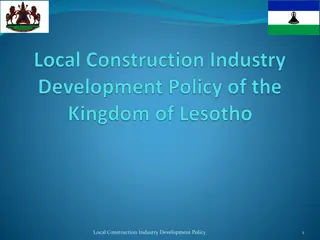
Modern Trends in Construction Materials_ Adapting to Industry Changes
Discover how the right construction supplies enhance project efficiency, streamline workflow, and ensure success in every building project.n
Download Presentation

Please find below an Image/Link to download the presentation.
The content on the website is provided AS IS for your information and personal use only. It may not be sold, licensed, or shared on other websites without obtaining consent from the author. If you encounter any issues during the download, it is possible that the publisher has removed the file from their server.
You are allowed to download the files provided on this website for personal or commercial use, subject to the condition that they are used lawfully. All files are the property of their respective owners.
The content on the website is provided AS IS for your information and personal use only. It may not be sold, licensed, or shared on other websites without obtaining consent from the author.
E N D
Presentation Transcript
Modern Trends in Construction Materials: Adapting to Industry Changes The world of construction is evolving at a breakneck pace. Gone are the days when bricks and mortar were the only game in town. Today, we're witnessing a revolution in construction materials that's reshaping skylines and redefining what's possible in building design. But let's face it - keeping up with these changes can be overwhelming. Whether you're a seasoned contractor or a homeowner planning your dream house, the sheer number of new materials and technologies hitting the market can make your head spin. You might be wondering: How do I choose the right materials for my project? Will these new options really save me money in the long run? And what about sustainability - how can I make sure my building isn't harming the planet? These are the questions that keep builders up at night. Technological Marvels: Building the Future 3D Printing: Bringing Sci-Fi to Life
Remember when 3D printing was just for making tiny plastic toys? Those days are long gone. Now, this technology is revolutionising the construction industry in ways that would make The Jetsons jealous. Imagine being able to "print" an entire house in a matter of days, using only the exact amount of material needed. That's the promise of 3D-printed concrete, and it's already becoming a reality. This technology allows for the creation of complex, eye-catching designs that would be incredibly difficult and expensive to achieve with traditional methods. But it's not just about looking cool. 3D printing in construction is a game-changer for efficiency and waste reduction. According to industry experts, this approach can slash construction waste by up to 30%, making it a win for both your wallet and the environment. Read More Article: Understanding the Role of Construction Supplies in Project Efficiency BIM: The Digital Blueprint Revolution If you've ever been on a construction site, you know that coordination can be a nightmare. Enter Building Information Modeling (BIM) - the digital superhero of modern construction. BIM isn't just a fancy 3D model of your building. It's a powerful collaboration tool that brings together architects, engineers, and contractors in a virtual space. This technology allows teams to spot potential issues before a single brick is laid, potentially saving millions in costly mistakes and delays. The numbers speak for themselves. A study by the National Institute of Standards and Technology found that BIM can reduce project costs by up to 15% and shorten completion times by up to 7%. Now that's what we call a smart investment! Smart Materials: The Self-Healing Revolution Imagine a world where buildings could repair themselves. Sounds like science fiction, right? Well, welcome to the future of construction materials. Self-healing concrete is leading the charge in this exciting new field. This innovative material contains tiny capsules of bacteria that activate when cracks form. The bacteria produce limestone, effectively "healing" the concrete and extending its lifespan.
While still in the early stages, the potential impact of self-healing materials is enormous. Experts estimate that implementing these technologies could reduce maintenance costs by up to 50% over the lifetime of a structure. That's a lot of money saved on repairs! Going Green: Building a Sustainable Future Eco-Friendly Materials: The New Gold Standard As the world grapples with climate change, the construction industry is stepping up to the plate with a range of sustainable materials that are as tough as they are green. Cross-laminated timber (CLT) is making waves as a renewable alternative to steel and concrete. This engineered wood product is incredibly strong and can be used to construct buildings up to 18 stories high. The best part? Trees absorb carbon as they grow, making CLT a carbon-negative material. Low-carbon concrete is another star player in the green building game. By replacing some of the cement with industrial byproducts like fly ash or slag, manufacturers can reduce the carbon footprint of concrete by up to 50%. Companies offering Concrete Mix London are increasingly incorporating these eco-friendly options into their product lines. Living Building Materials: Nature's Builders If you thought self-healing concrete was cool, wait until you hear about living building materials. These innovative products incorporate live organisms that can grow, heal, and even clean the air around them. One exciting example is bricks made with sand and bacteria. These living bricks can reproduce, creating three new bricks from one original in about 9 hours. Not only does this reduce the need for energy-intensive manufacturing, but the bricks also absorb CO2 as they grow. While still in the experimental stage, living building materials represent a paradigm shift in how we think about construction. They offer the potential to create buildings that are not just structures, but living, breathing entities that contribute positively to their environment.
The Circular Economy: Waste Not, Want Not The days of "take, make, dispose" are coming to an end. The construction industry is embracing the circular economy, where materials are reused, recycled, and repurposed to minimise waste. Recycled steel is leading the charge in this area. By using scrap metal instead of virgin ore, steel producers can reduce energy consumption by up to 75% and CO2 emissions by up to 58%. That's a significant impact, considering steel is one of the most widely used materials in construction. But it's not just about recycling. The industry is also exploring ways to design buildings for easy disassembly, allowing components to be reused in future projects. This approach could reduce construction waste by up to 90%, according to some estimates. Economic Realities: Challenges & Opportunities Material Costs and Shortages: The Supply Chain Squeeze It's no secret that the construction industry has been facing some serious headwinds when it comes to materials. The perfect storm of pandemic-related disruptions, increased demand, and geopolitical tensions has sent prices soaring and availability plummeting. Steel prices, for example, have seen increases of up to 200% in some markets. Aluminum, copper, and lumber have all experienced similar spikes. This volatility is putting pressure on construction firms to get creative with their sourcing and budgeting. Material Price (2020-2021) Increase Steel Up to 200% Lumber Up to 300% Copper Up to 50% Aluminum Up to 70% Read More Article: Construction Supplies 101: A Guide to Tools and Materials
Labor Shortages: The Skills Gap Challenge While new materials and technologies are exciting, they're only as good as the people who know how to use them. Unfortunately, the construction industry is facing a severe shortage of skilled workers. According to industry reports, up to 41% of the current construction workforce is expected to retire by 2031. This brain drain is pushing companies to invest heavily in training and automation to bridge the gap. Off-site construction methods, like prefabrication and modular building, are gaining traction as a way to do more with fewer workers. These approaches can reduce on-site labor needs by up to 50%, helping to offset the impact of the skills shortage. The Housing Boom: Opportunity Knocks It's not all doom and gloom, though. The residential housing market has been on fire, driven by low mortgage rates and the shift towards remote work. This surge in demand has been a boon for the building supply industry. Concrete mix London suppliers, in particular, have seen increased orders as homeowners invest in renovations and new construction. This trend is expected to continue, with the global ready-mix concrete market projected to grow at a CAGR of 6.8% from 2021 to 2028. Conclusion The future of construction is about more than just putting up buildings. It's about creating smarter, more sustainable structures that work in harmony with the environment and meet the changing needs of society. By staying informed and adaptable, we can all play a part in building a better tomorrow. Pro-Mix Concrete - Building the Future, Today At Pro-Mix Concrete, we're not just keeping up with industry trends - we're setting them. Our advanced Ready Mix Concrete formulations combine strength, sustainability, and innovation to meet the demands of modern construction. With Pro-Mix, you're not just pouring concrete - you're laying the foundation for a greener, smarter future. Site Article: Modern Trends in Construction Materials: Adapting to Industry Changes






















